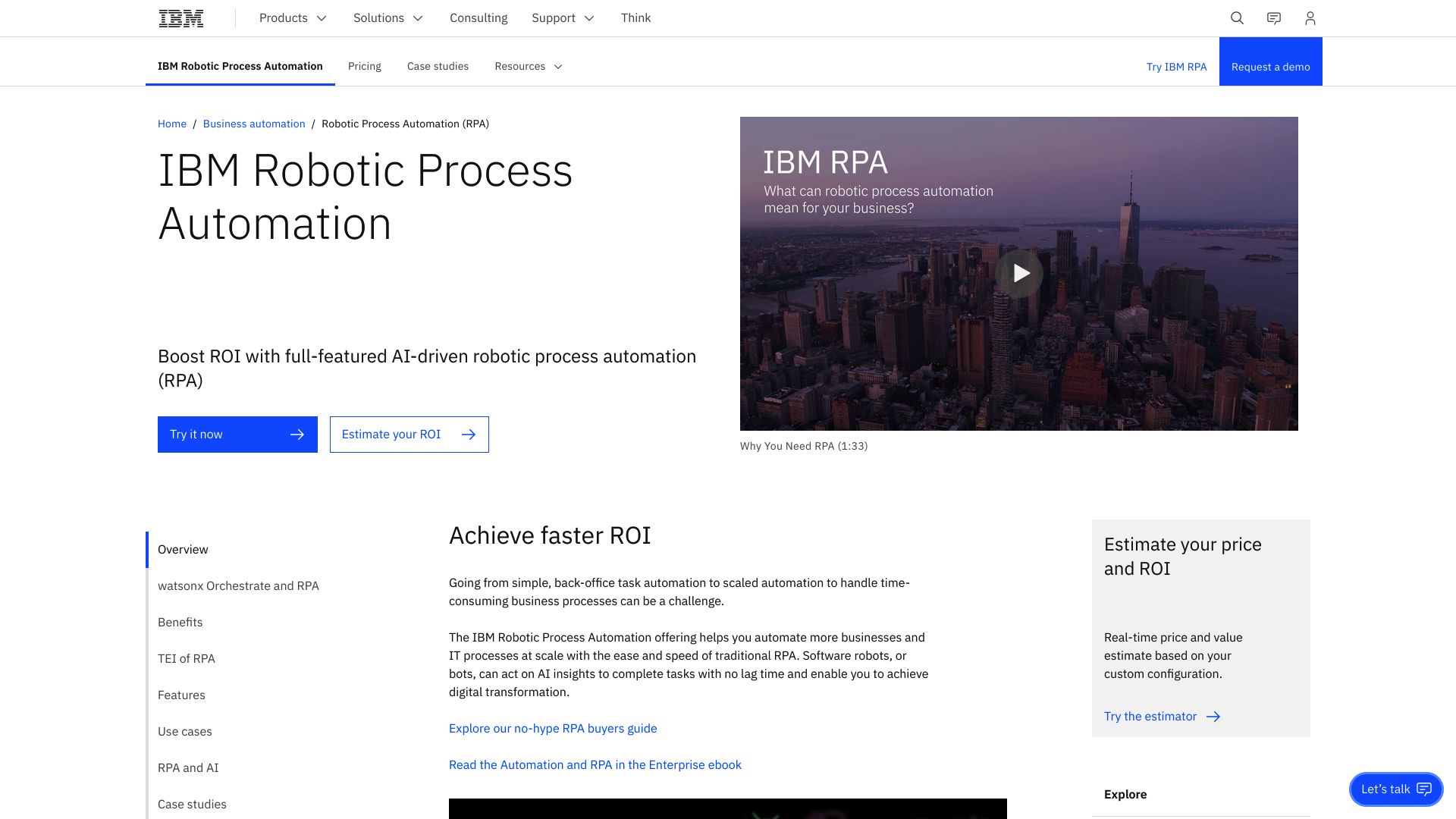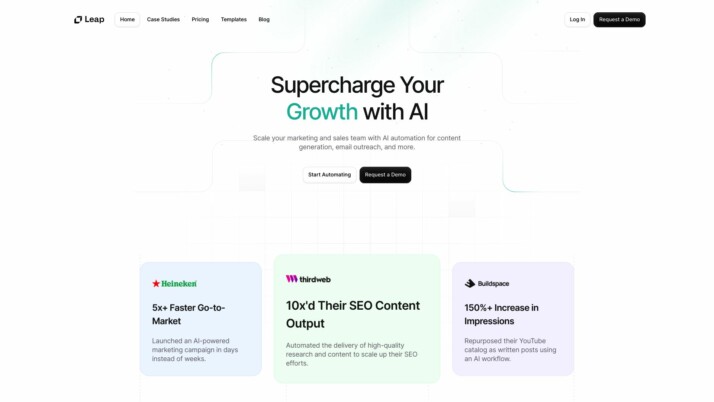IBM RPA vs. Leap AI: Enterprise Security or Rapid Development?
AI automation platforms revolutionize business operations, empowering organizations to streamline processes and boost productivity. This comparison delves into IBM RPA vs. Leap AI, and SmythOS, exploring their unique features, strengths, and potential limitations. We’ll examine how each platform addresses enterprise needs, supports rapid development, and enables AI-driven decision-making.
By the end, you’ll understand which solution best fits your organization’s automation goals, whether you’re a large corporation seeking robust security and compliance or a smaller team looking for accessible AI implementation. Discover how these platforms are shaping the future of work and learn which one could transform your business operations.
IBM RPA Overview
IBM RPA transforms business operations through intelligent automation. This enterprise-grade platform empowers organizations to create, deploy, and manage software robots that streamline repetitive tasks across various applications and systems.


IBM RPA’s low-code visual builder enables both technical and non-technical users to design automation workflows efficiently. The platform supports attended and unattended bots, facilitating seamless human-AI collaboration. Its AI-driven capabilities, powered by watsonx Orchestrate, allow for intelligent decision-making and custom skill development.
IBM RPA’s low-code visual builder enables both technical and non-technical users to design automation workflows efficiently.
Integration with common enterprise applications like SAP, Office, and Java makes IBM RPA a versatile solution for diverse business needs. The platform ensures scalability through distributed runtime environments and orchestration processes, supporting concurrent bot execution for complex, multi-step automations.
Security and compliance remain paramount, with IBM RPA offering robust governance tools, including integration with IBM OpenPages. This ensures transparency, auditability, and adherence to regulatory requirements. While the platform excels in enterprise environments, it may have a steeper learning curve for smaller organizations or individual users compared to some more user-friendly alternatives.
IBM RPA positions itself as a comprehensive solution for businesses seeking to enhance productivity and efficiency through automation. Its focus on enterprise-grade features, scalability, and integration capabilities makes it a strong contender for large-scale deployments, though smaller businesses might find more accessible options elsewhere in the market.
Leap AI Overview
Leap AI empowers users to create sophisticated AI workflows without coding expertise. The platform’s no-code interface allows rapid development of AI-powered applications, from chatbots to content generators. Leap AI’s strength lies in its versatility, supporting various AI models like OpenAI GPT, Mistral 7b, and Stable Diffusion XL for tasks ranging from text analysis to image creation.


Leap AI empowers users to create sophisticated AI workflows without coding expertise. The platform’s no-code interface allows rapid development of AI-powered applications, from chatbots to content generators.
The platform shines in its integration capabilities. Leap AI seamlessly connects with popular tools such as Slack, Hubspot, and Zapier, enabling users to enhance existing workflows with AI. This interoperability positions Leap AI as a valuable asset for businesses looking to incorporate AI into their operations without overhauling their tech stack.
Leap AI’s extensive template library accelerates development, offering pre-built solutions for common use cases like blog post generation and lead summarization. Users can also fine-tune and train custom models using their datasets, tailoring AI outputs to specific needs. While this customization is powerful, it may require a learning curve for users unfamiliar with AI model training concepts.
Leap AI provides comprehensive SDK support, including RESTful API, TypeScript, and Python, facilitating integration into various applications. However, developers might find the platform’s focus on no-code solutions limiting for highly complex or unique AI implementations that require lower-level control.
Leap AI provides comprehensive SDK support, including RESTful API, TypeScript, and Python, facilitating integration into various applications.
The platform’s user-friendly dashboard allows for visual design and execution of workflows, making AI accessible to a broader audience. This approach democratizes AI technology, enabling non-technical users to leverage advanced capabilities. However, power users might find the visual interface constraining for intricate AI agent designs.
Feature Comparison
IBM RPA and Leap AI both offer powerful AI automation capabilities, but significant feature gaps exist between them. IBM RPA excels in enterprise-grade security and compliance, integrating with IBM OpenPages for robust governance and audit logging. This level of security is not explicitly mentioned for Leap AI, potentially making IBM RPA more suitable for highly regulated industries.
In terms of core components, IBM RPA provides extensive support for attended and unattended bots, enabling both human-AI collaboration and fully autonomous operations. Leap AI, while offering AI workflow creation, does not specifically highlight bot capabilities, suggesting a potential gap in robotic process automation features. IBM RPA’s integration with watsonx Orchestrate also allows for more advanced AI-driven decision-making and custom skill development, which may surpass Leap AI’s offerings in complex enterprise scenarios.
However, Leap AI distinguishes itself with its no-code visual interface and extensive template library, making AI development more accessible to non-technical users. While IBM RPA offers low-code tools, Leap AI’s focus on user-friendly design could provide an edge in rapid AI application deployment for smaller teams or businesses without dedicated IT resources. Additionally, Leap AI’s support for various AI models like OpenAI GPT and Stable Diffusion XL offers flexibility in AI tasks that may not be as readily available in IBM RPA’s more structured enterprise environment.
Feature Comparison Table
| IBM RPA | Leap AI | SmythOS | |
|---|---|---|---|
| CORE FEATURES | |||
| AI Agents | ❌ | ✅ | ✅ |
| Hosted Agents (Dev, Production) | ✅ | ❌ | ✅ |
| Memory & Context | ❌ | ✅ | ✅ |
| Autonomous Agents | ❌ | ❌ | ✅ |
| Explainability & Transparency | ❌ | ❌ | ✅ |
| Debug Tools | ✅ | ❌ | ✅ |
| Multimodal | ❌ | ✅ | ✅ |
| Problem-Solving Capabilities | ❌ | ✅ | ✅ |
| Multi-Agent Collaboration | ❌ | ❌ | ✅ |
| Work as Team | ❌ | ✅ | ✅ |
| SECURITY | |||
| Constrained Alignment | ❌ | ❌ | ✅ |
| OAuth | ❌ | ✅ | ✅ |
| IP Control | ❌ | ✅ | ✅ |
| COMPONENTS | |||
| Foundation AIs | ❌ | ✅ | ✅ |
| Huggingface AIs | ❌ | ✅ | ✅ |
| Zapier APIs | ❌ | ✅ | ✅ |
| Classifiers | ❌ | ✅ | ✅ |
| Data Lakes | ❌ | ❌ | ✅ |
| DEPLOYMENT OPTIONS (EMBODIMENTS) | |||
| Deploy as Webhook | ❌ | ✅ | ✅ |
| Staging Domains | ❌ | ✅ | ✅ |
| Production Domains | ❌ | ✅ | ✅ |
| API Authentication (OAuth + Key) | ❌ | ✅ | ✅ |
| Deploy as Site Chat | ❌ | ✅ | ✅ |
| Deploy as GPT | ❌ | ✅ | ✅ |
| DATA LAKE SUPPORT | |||
| Hosted Vector Database | ❌ | ❌ | ✅ |
| Sitemap Crawler | ❌ | ✅ | ✅ |
| YouTube Transcript Crawler | ❌ | ✅ | ✅ |
| URL Crawler | ❌ | ✅ | ✅ |
Best Alternative to IBM RPA and Leap AI
SmythOS stands out as the superior alternative to IBM RPA and Leap AI, offering a comprehensive AI automation platform that combines ease of use with powerful features. Our drag-and-drop interface enables users to create sophisticated AI workflows without extensive coding knowledge, making advanced AI accessible to a broader audience.
Unlike IBM RPA’s focus on enterprise-specific solutions, SmythOS provides unlimited use cases across industries. We offer a versatile toolkit that includes pre-built API integrations, support for various AI models, and the ability to deploy agents as APIs, chatbots, or scheduled tasks. This flexibility allows businesses to tailor AI solutions to their unique needs more effectively than Leap AI’s template-based approach.
SmythOS offers unparalleled scalability and integration capabilities… providing a level of versatility that surpasses both IBM RPA and Leap AI.
SmythOS excels in multi-agent collaboration, a feature lacking in both IBM RPA and Leap AI. Our platform enables teams of AI agents to work together on complex tasks, significantly enhancing problem-solving capabilities and operational efficiency. This collaborative approach sets SmythOS apart in handling intricate business processes and decision-making scenarios.
While Leap AI offers some no-code options, SmythOS takes usability a step further by combining intuitive design with robust debugging tools and explainable AI features. We provide transparency in AI operations, allowing users to understand and refine their AI agents’ decision-making processes—a critical aspect for businesses requiring accountability and trust in their AI systems.
Furthermore, SmythOS offers unparalleled scalability and integration capabilities. Our platform seamlessly connects with various data sources, APIs, and AI models, providing a level of versatility that surpasses both IBM RPA and Leap AI. This comprehensive approach ensures that businesses can create, deploy, and manage AI agents that truly meet their evolving needs, making SmythOS the ideal choice for organizations looking to harness the full potential of AI automation.
Conclusion
IBM RPA and Leap AI offer powerful automation solutions, each with unique strengths. IBM RPA excels in enterprise environments, providing robust security, compliance, and integration capabilities crucial for large-scale deployments. Its support for attended and unattended bots, coupled with AI-driven decision-making through watsonx Orchestrate, positions it well for complex, multi-step automations in regulated industries.
Leap AI, on the other hand, shines in its accessibility and rapid development capabilities. Its no-code interface and extensive template library democratize AI application creation, making it an attractive option for smaller teams or businesses seeking quick AI implementation without deep technical expertise.
However, SmythOS emerges as the superior choice, combining the best of both worlds and pushing the boundaries of AI automation further. Our platform offers unparalleled flexibility with its drag-and-drop interface, extensive integration ecosystem, and support for multiple AI models. SmythOS not only matches the enterprise-grade security and scalability of IBM RPA but also provides the user-friendly experience and rapid deployment capabilities of Leap AI.
What sets SmythOS apart is its ’Create Once, Deploy Anywhere’ philosophy, allowing users to build AI agents that seamlessly integrate across various platforms and services. This versatility, combined with features like multi-agent collaboration, advanced debugging tools, and support for multimodal interactions, makes SmythOS the ideal solution for businesses of all sizes looking to harness the full potential of AI automation.
To experience the future of AI workforce automation, we invite you to explore our diverse range of AI-powered agent templates and create a free SmythOS account. With our risk-free trial offering unlimited agents and a 30-day money-back guarantee, you can start building and deploying sophisticated AI solutions today, revolutionizing your workflow and driving innovation across your organization.
Last updated:
Disclaimer: The information presented in this article is for general informational purposes only and is provided as is. While we strive to keep the content up-to-date and accurate, we make no representations or warranties of any kind, express or implied, about the completeness, accuracy, reliability, suitability, or availability of the information contained in this article.
Any reliance you place on such information is strictly at your own risk. We reserve the right to make additions, deletions, or modifications to the contents of this article at any time without prior notice.
In no event will we be liable for any loss or damage including without limitation, indirect or consequential loss or damage, or any loss or damage whatsoever arising from loss of data, profits, or any other loss not specified herein arising out of, or in connection with, the use of this article.
Despite our best efforts, this article may contain oversights, errors, or omissions. If you notice any inaccuracies or have concerns about the content, please report them through our content feedback form. Your input helps us maintain the quality and reliability of our information.
